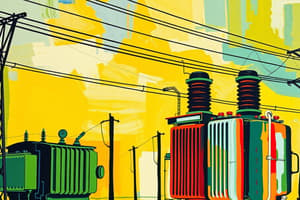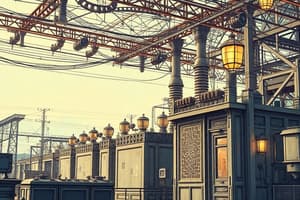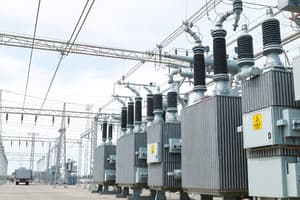Podcast
Questions and Answers
Which of the following statements about superconductors is true?
Which of the following statements about superconductors is true?
- All superconductors are naturally occurring elements.
- Superconductors can consist of a mix of two or more metals. (correct)
- Superconductors are the same as insulators.
- Superconductors have zero resistance at room temperature.
What is a primary characteristic of conductors?
What is a primary characteristic of conductors?
- They possess free electrons that allow electricity to flow. (correct)
- They are typically non-metal elements.
- They can only conduct electricity at high temperatures.
- Electrons are tightly held and do not move freely.
Which of the following materials is least likely to be an effective conductor of electricity?
Which of the following materials is least likely to be an effective conductor of electricity?
- Copper
- Gold
- Aluminum
- Plastic (correct)
What is the consequence of increasing voltage in an insulator?
What is the consequence of increasing voltage in an insulator?
Which of the following materials is considered a good conductor of electricity?
Which of the following materials is considered a good conductor of electricity?
What factor primarily determines the effectiveness of a material as an insulator?
What factor primarily determines the effectiveness of a material as an insulator?
What is the relationship between temperature and the conductive properties of superconductors?
What is the relationship between temperature and the conductive properties of superconductors?
Which of the following is NOT an example of a good conductor of electricity?
Which of the following is NOT an example of a good conductor of electricity?
What is the relationship defined by the equation I = Q/T?
What is the relationship defined by the equation I = Q/T?
In what scenario would current be zero in a circuit?
In what scenario would current be zero in a circuit?
How does the direction of conventional current differ from electron flow?
How does the direction of conventional current differ from electron flow?
Which of the following best describes alternating current (AC)?
Which of the following best describes alternating current (AC)?
What defines the role of a resistor in a circuit?
What defines the role of a resistor in a circuit?
What does the third band in a resistor color code signify?
What does the third band in a resistor color code signify?
Why do conductors become hot when current passes through?
Why do conductors become hot when current passes through?
Which of the following correctly describes the relationship defined by Ohm's Law?
Which of the following correctly describes the relationship defined by Ohm's Law?
What is the primary characteristic of a direct current (DC) circuit?
What is the primary characteristic of a direct current (DC) circuit?
What is the primary function of a diode in an electronic circuit?
What is the primary function of a diode in an electronic circuit?
Which statement best explains the difference between conductors and insulators in terms of electricity?
Which statement best explains the difference between conductors and insulators in terms of electricity?
How is capacitance typically measured in small electronic capacitors?
How is capacitance typically measured in small electronic capacitors?
Which formula correctly represents the calculation of power in an electrical circuit?
Which formula correctly represents the calculation of power in an electrical circuit?
What does a capacitor do in an electronic circuit?
What does a capacitor do in an electronic circuit?
What is the significance of the shorter terminal on a polarized capacitor?
What is the significance of the shorter terminal on a polarized capacitor?
Which of the following accurately describes the term 'milli' in electrical units?
Which of the following accurately describes the term 'milli' in electrical units?
What is the primary function of transformers in high voltage electricity distribution?
What is the primary function of transformers in high voltage electricity distribution?
Which device can be reset after tripping due to an overload?
Which device can be reset after tripping due to an overload?
What unit is used to measure electric energy consumption in homes?
What unit is used to measure electric energy consumption in homes?
What is the relationship between volts and coulombs in terms of potential difference?
What is the relationship between volts and coulombs in terms of potential difference?
How do fuses prevent electrical hazards?
How do fuses prevent electrical hazards?
What is the function of current in an electric circuit?
What is the function of current in an electric circuit?
What does the term 'power' measure in relation to energy usage?
What does the term 'power' measure in relation to energy usage?
Which of the following correctly describes amperes in electrical terms?
Which of the following correctly describes amperes in electrical terms?
What is the function of a transistor in an electronic circuit?
What is the function of a transistor in an electronic circuit?
What distinguishes a BJT from a FET?
What distinguishes a BJT from a FET?
Which component's configuration uses the terms Collector, Emitter, and Base?
Which component's configuration uses the terms Collector, Emitter, and Base?
What characteristic differentiates NPN from PNP transistors?
What characteristic differentiates NPN from PNP transistors?
Which component emits light when electricity passes through it?
Which component emits light when electricity passes through it?
What is typically included on the front side of a printed circuit board?
What is typically included on the front side of a printed circuit board?
Which statement is true regarding integrated circuits?
Which statement is true regarding integrated circuits?
How does a potentiometer function?
How does a potentiometer function?
Flashcards are hidden until you start studying
Study Notes
Conductors and Insulators
- Conductors allow electricity to flow easily due to their free-moving electrons.
- Metals, especially copper, iron, silver, and aluminum, are excellent conductors; silver is the best but costly.
- Insulators resist the flow of electricity due to tightly held outer electrons. Common insulators include glass, wood, plastic, and rubber.
- Insulating materials cover conductive materials to prevent electric shocks.
Superconductors
- Superconductors enable zero resistance to electric flow but only at extremely low temperatures (below -200 degrees Celsius).
- Typically consist of two or more metals mixed together.
Electrical Safety in the Home
- Overheating in wires from excessive current can cause fires.
- Fuses melt to break the circuit at predetermined current levels; they need replacement.
- Circuit breakers are resettable switches that turn off when overheating occurs.
Basic Electrical Measurements
- The volume of electricity consumed at home is measured in kilowatt-hours (kWh).
- 1 kilowatt = 1000 watts; 1 watt = joule/second, measuring energy usage.
Voltage, Current, and Resistance
- Voltage (E, volts) measures work needed to move one coulomb of charge.
- Current (I, amperes) is the flow of charge, calculated as I = Q/T, where Q is charge and T is time.
- Resistance impedes the flow of current; ohmic materials have minimal resistance.
- Ohm’s Law relates voltage, current, and resistance: I = V/R, V = IR, R = V/I.
Types of Current
- Direct Current (DC) flows in one direction, typically from batteries.
- Alternating Current (AC) periodically reverses direction.
Components in Circuits
- Resistors limit current flow, defined by color codes indicating resistance values and tolerances.
- Capacitors store electrical energy, measured in farads, often found in microfarads and nanofarads.
- Diodes allow current to flow in one direction, preventing damage from reversed polarity; they protect electronic circuits.
- Light Emitting Diodes (LEDs) emit light when electricity passes through.
Variable Resistors and Transistors
- Potentiometers change resistance manually by turning a dial.
- Transistors amplify and switch electronic signals, made of semiconductor material with three terminals (collector, emitter, base).
Integrated Circuits and Circuit Boards
- Integrated Circuits (ICs) contain various transistors acting as the control unit of electronic circuits.
- Printed Circuit Boards (PCBs) attach components with printed information to guide assembly and functionality.
Terminology
- Bipolar Junction Transistor (BJT) and Field-Effect Transistor (FET) serve as amplifiers and switches in circuits.
- NPN and PNP describe the arrangement of semiconductors within transistors.
General Considerations
- Always remember that electricity takes the shortest path to the ground, impacting how power is distributed.
- Understanding the role and function of each component aids in circuit design and troubleshooting.
Studying That Suits You
Use AI to generate personalized quizzes and flashcards to suit your learning preferences.





